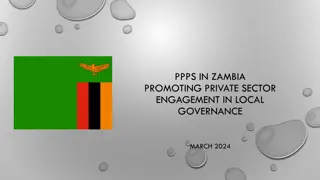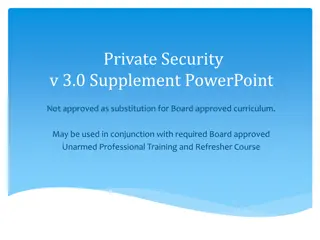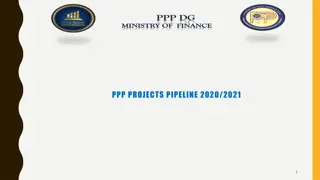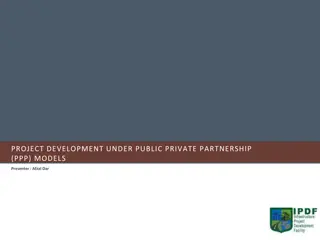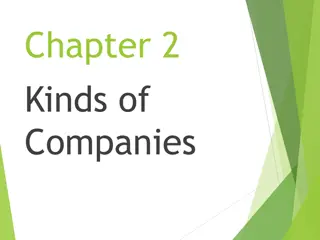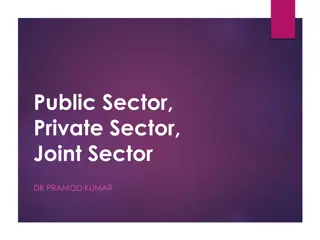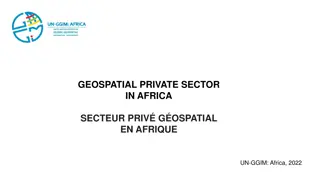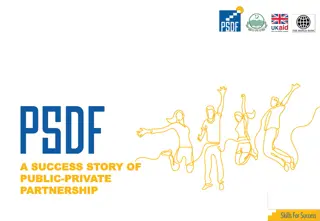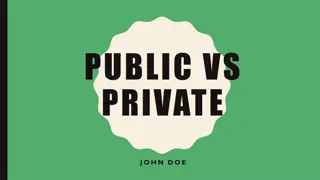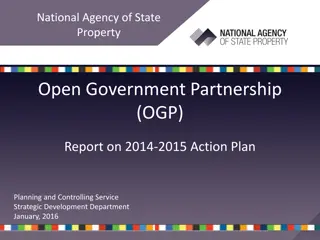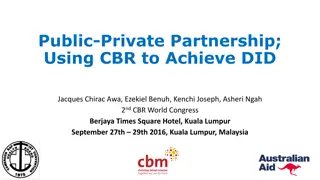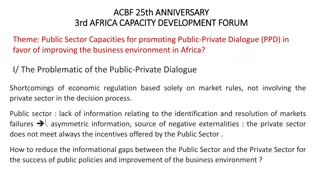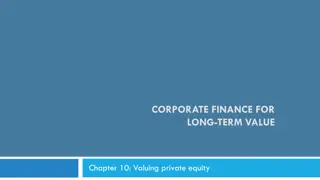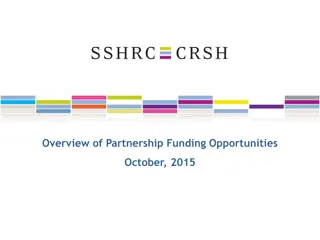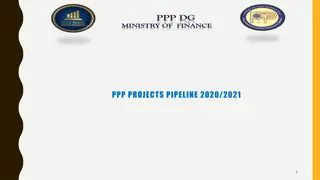National Public Private Partnership Policy 2011
An arrangement between the government and private sector for the creation of public assets or delivery of public services. This partnership focuses on harnessing private sector efficiencies, innovation, and technological improvements to provide affordable and improved services. Investments are made by private sector entities with risk sharing and performance-linked fee structures. PPPs help meet demands for modern facilities, infrastructure, and services while providing value for taxpayers. Various contract models, such as Design-Build and Build-Operate-Transfer, are utilized for efficient project development and operation.
- Efficient Service Delivery
- Private Sector Efficiencies
- Innovation
- Investments
- Risk Sharing
- Performance-linked Fees
- Infrastructure
- Taxpayers
- Contract Models
Download Presentation

Please find below an Image/Link to download the presentation.
The content on the website is provided AS IS for your information and personal use only. It may not be sold, licensed, or shared on other websites without obtaining consent from the author. Download presentation by click this link. If you encounter any issues during the download, it is possible that the publisher has removed the file from their server.
E N D
Presentation Transcript
Shankar LalVerma Md. ImteazAlam SomeshSuman Md. SajidSultan Madhura Roy Satyajeet Kumar PreetiSingh KapilChandrawal Kalpesh Rupavatiya K.K. Mishra
Arrangement between government & private sector entity for public asset creation or public service delivery For specified period of time Performance measurable by Public entity or its representative
Harness Private Sector efficiencies Focus of Life Cycle approach for development of any project Innovation and Technological improvements Provision of affordable and improved services
Investments made by Private sector entity Risk sharing with the private sector Performance linked fee payment structure &/or through user charges Conformance to performance standards
PPPs help governments meet demands for the development of modern and efficient facilities, infrastructure and services while providing value for taxpayers
Design-Build (DB) Design Build-Operate (DBO) Operation & Maintenance Contract (O & M) Design-Build-Finance-Maintain (DBFM) Design-Build-Finance-Maintain-Operate (DBFMO) Build-Own-Operate (BOO) Build OperateTransfer(BOT) Build-Own-Operate-Transfer(BOOT) Buy Build Operate (BBO) Build-Own-Lease-Transfer(BOLT) Lease Renovate Operate and Transfer (LROT)
1. Genesis 2. Feasibility 3. Plan & Test 4. Procure 5. Implement 6. Operations
Fair and Transparent Framework Plan, Priorities and Manage Projects Process for selection & ensure efficient governance Protect interest of end users Ensure efficient delivery Achieve efficiency in deployment of investment Liability clause
Recognize the imperative to accelerate PPP Critical intervention envisaged Enhancing transparency in PPP projects PPP rules Auctioning Smooth implementation of Project Preferred Model of implementation
BOT User Fee Based Annuity Based Performance Based Turnkey Contracts BLT DBFOT OMT BOO
Public Good is a good that is both Non- excludable and Non-rivalrous Examples: Infrastructure Airports/Ports Roadways Railways Health Education Telecom Energy R&D
Easing Budgetary Constraints Value for money issue A realistic control of cost A streamlined construction schedule and reliable project implementation enable enhanced economic development Assets creation, maintenance and service delivery Set on sustainable and environmentally -Compatible development Social benefits Transparency Transfer of technology Project stability Focusing the Role of Public Authority on its Regulatory function
Both the public entity and the private firm is seeking to gain from the relationship-user ends up paying more Involves high risk level Long term contracts not reliable
1stGeneration PPP Projects: Asset Monetization -Indiana Toll Road 2ndGeneration PPP Projects: Variable pricing -the Port of Miami Tunnel, I-595 express lanes 3rdGeneration PPP Projects: Value-for-money (VfM), Cost-benefit analysis -Dulles Toll Road, State Highways 121
1992 -private finance initiative (PFI), -focussed on reducing thePublic Sector Borrowing Requirement 1997 - expanded the PFI initiative shift the emphasis "value for money London Underground PPP to the achievement of
1993 -Canadian Council for Public-Private Partnerships 2009 -creation of a crown corporation, National Awards Program Ontario Highway 407. Canada Line rapid transit
European PPP Expertise Centre (EPEC) Roll Back Malaria (RBM) Partnership Australia -Airport Link,Cross City Tunnel, Sydney Harbour Tunnel, Global public private partnership (GPPP)
National organizations Central & Local government bodies Implementing Firm End users Employees Middlemen Local businesses (audit commission, regulatory bodies) Pressure groups Residents (electorate, tax payers)
T3 at IGI Airport Yamuna Expressway Akshay Patra Foundation GujratSolar Power Electricity (RVVNL)
Hyderabad Metro:Maytas Vadodra Halol-Toll project KG Basin Nuclear Power plants installation
PPPP: Public private panchayat partnership Social audit committee Community led: For low cost projects For non-durable assets At micro- level Private panchayat partnership: In contract farming In developing agriculture market
Applicable area: high awareness level Exploring new areas: Agri-marketing SHGs Contract farming Energy sectors
Transparent: RTI compliance Accountability: RFD compliance Social Audit : Inclusiveness SIA/EIA compliance


